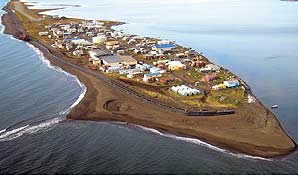High court could melt climate-change cases
Publication Type:
Web ArticleSource:
The National Law Journal | Law.com (2010)URL:
http://www.law.com/jsp/nlj/legaltimes/PubArticleLT.jsp?id=1202471899404&High_court_could_melt_climatechange_casesKeywords:
legalNotes:
Perched on an Alaskan barrier island, the village of Kivalina faces imminent destruction because of melting sea ice.

Kivalina, Alaska, has sued energy companies over
melting sea ice that threatens the town.
AP Photo/Northwest Arctic Borough
Now, the community's legal effort — which pins the blame on energy companies for the change in climate — is in danger as well. So, too, is a pair of high-profile climate-change suits that may be taken up by the U.S. Supreme Court, one involving an effort by Connecticut and other states to reduce greenhouse-gas emissions, the other stemming from Hurricane Katrina.
See: Greenhouse Gas Emissions Case Heads to Supreme Court.
See: SCOTUS (Supreme Court of the United States) Blog.
All three suits rely upon the theory that climate change is a public nuisance and, therefore, state and local governments, as well as individuals who have been harmed, can sue for damages or injunctions. The Obama administration, in a recently filed brief in the Connecticut case, American Electric Power v. Connecticut, is arguing that it may not be prudent for the high court to allow these types of cases to go forward.
If the justices grant review, the stage could be set for reversal of a rare, recent high court victory for environmentalists, the 2007 decision in Massachusetts v. Environmental Protection Agency. The 5-4 ruling in the Massachusetts case found a special standing to sue for states that brought that first global-warming case to the Supreme Court. The majority also held that the Environmental Protection Agency (EPA) had authority under the Clean Air Act to regulate greenhouse-gas emissions.
"If the solicitor general gets the Court to take cert, I would be very confident they're going to undercut Massachusetts v. EPA," said environmental scholar Randall Abate of Florida A&M University College of Law. "The sooner the Court gets to revisit it, the more likely it will be gutted. The trend has been to be more restrictive on standing. This is really making the environmental community nervous and angry."
The Katrina-related case — In re Ned Comer — is also at the Supreme Court but is coming to justices in an unusual fashion — through a petition for a writ of mandamus. The Alaska case — Native Village of Kivalina v. Exxon Mobil Corp. — is undergoing briefing in the U.S. Court of Appeals for the 9th Circuit.
 "Each case has its legal strong points and each has its legal vulnerabilities," said James May of Widener University School of Law, who has filed amicus briefs on behalf of environmental law professors in the Connecticut and Kivalina cases.
"Each case has its legal strong points and each has its legal vulnerabilities," said James May of Widener University School of Law, who has filed amicus briefs on behalf of environmental law professors in the Connecticut and Kivalina cases.
"As a federal litigator for 15 years and a law professor for 20, what I find concerning is the executive branch stepping in front of states and private litigants who are trying to get their day in court. If this was the Bush administration doing this, I think it would be a very divisive political issue."
...The energy companies' case is now stronger because of the EPA's actions and the solicitor general's brief, he said. "I don't know if it gets you there finally. If I was writing plaintiffs' briefs, I would be pounding the table and saying, `If you're telling me this is a political question, the political arm to deal with this is Congress and they have done nothing.' "
 Which is exactly what Pawa, who represents three land trusts in the Connecticut case as well as the Kivalina villagers, said. "The solicitor general's brief is not very damaging because it was unpersuasive," Pawa said. "It's just wrong. It tries to repackage the political-question doctrine, which was thoroughly dealt with on its merits by the 2d Circuit, as prudential standing.
Which is exactly what Pawa, who represents three land trusts in the Connecticut case as well as the Kivalina villagers, said. "The solicitor general's brief is not very damaging because it was unpersuasive," Pawa said. "It's just wrong. It tries to repackage the political-question doctrine, which was thoroughly dealt with on its merits by the 2d Circuit, as prudential standing.
"And, there are no federal regulations applicable to existing coal-fired power plants. They haven't even been proposed. There have been some rules proposed for new plants, but no rules for existing plants, which are at issue in these lawsuits."
In looking at the various iterations of climate-change litigation, the most "evolved" of the three cases is Kivalina, according to Jones and others, and the one that worried most corporate defendants. "It contained a conspiracy count, which is what the plaintiffs' bar hoped would get them money damages," Jones said. "And it has more sympathetic and real plaintiffs than the other cases. Here you have a particular village that is going to be under water."
Kivalina from Cristina Valdivieso + Jon Connor on Vimeo.
Various scientific and government studies report that the right combination of storms could flood the entire village at any time and have recommended relocation at costs varying up to $400 million.
If the Court does not act on Connecticut or Comer, Jones said, "I think Kivalina will go forward. I think that one could end up being the most dangerous of any of them. But getting into court is one thing; proving causation is a very hard row to hoe."
See: Shearer, Christine. "My Journey Into Kivalina v. ExxonMobil et al." Countercurrents. Dec. 1, 2010.
See also: Shearer, Christine. Kivalina: A Climate Change Story. Haymarket Books, 2011. Print.





